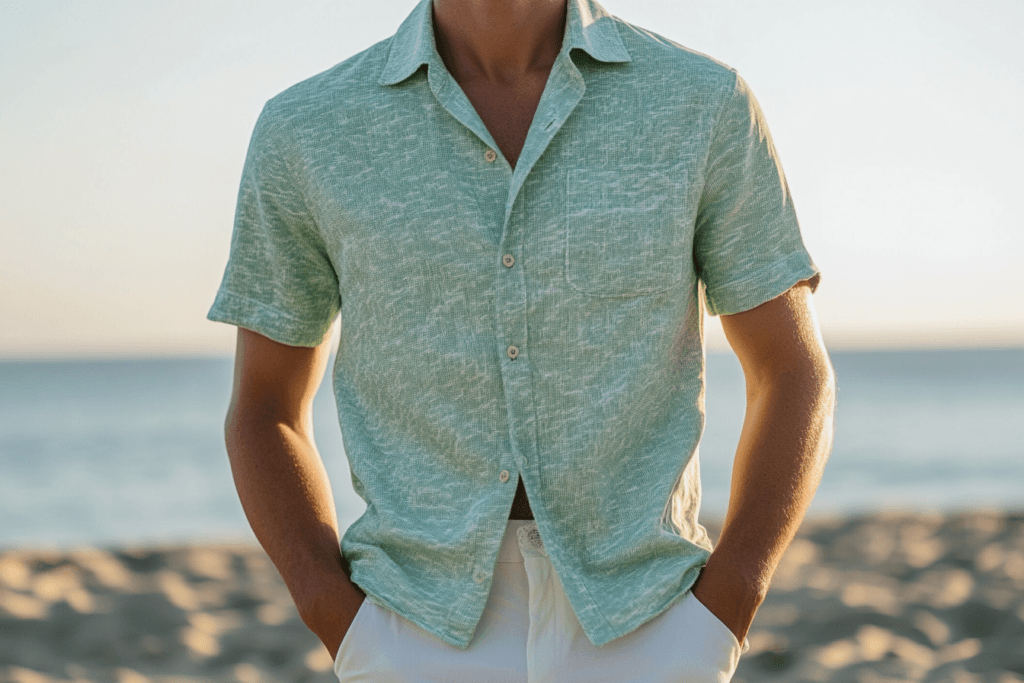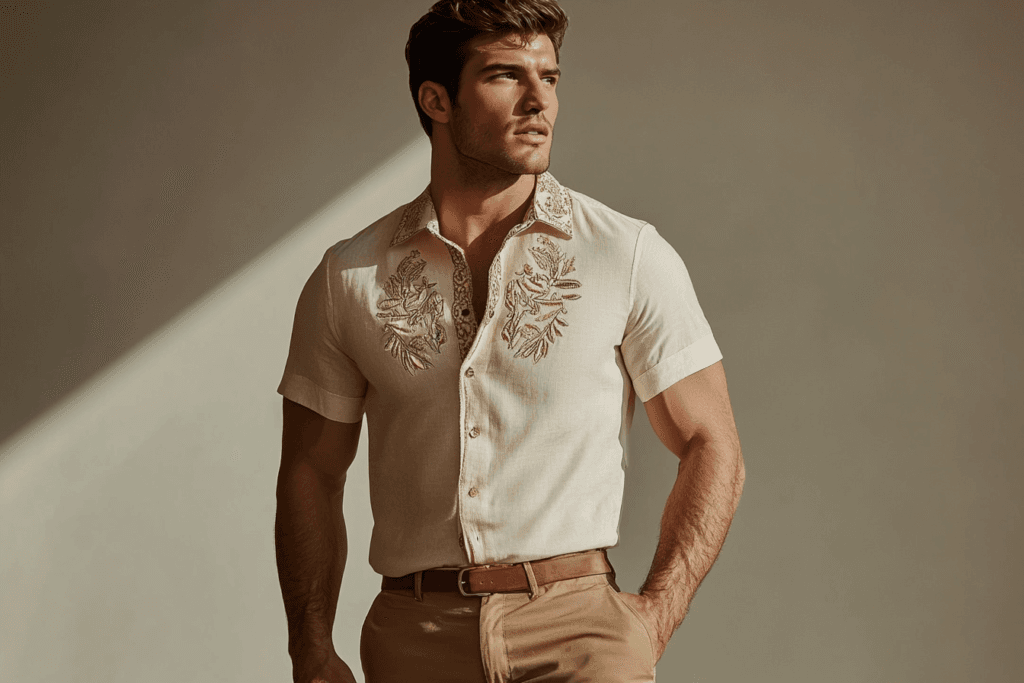
When discussing eco-friendly fashion, the comparison of bamboo vs. modal is quite popular. People are drawn to these fibers because they are more sustainable for the planet. Here are some important facts about this trend:
- Around 60% of people will pay more for eco-friendly clothes, such as bamboo outfits.
- About 66% of shoppers worldwide prefer sustainable clothing options.
- The bamboo yoga clothes market is projected to grow over 8% each year until 2025.
These statistics highlight the growing concern for sustainability in fashion. By examining bamboo vs. modal, you can make an informed choice that aligns with your values and comfort preferences.
Key Takeaways
- Bamboo and modal are eco-friendly fabrics with different benefits.
- Bamboo grows fast and needs little water, so it’s sustainable.
- Modal comes from beech trees and uses less waste in production.
- Bamboo fabric is soft and gentle, perfect for sensitive skin.
- Modal fabric feels silky and works well for activewear.
- Bamboo lasts longer and is easier to care for than modal.
- Pick bamboo for comfy, everyday clothes, especially in warm weather.
- Choose modal for stylish outfits or activewear that stays smooth.
1. Where Do Bamboo and Modal Fibers Come From, and How Are They Made?
How Bamboo Fiber Is Made
Mechanical vs. Chemical Processing
Bamboo fiber is made in two ways: mechanical or chemical. The mechanical method uses enzymes to break down bamboo into pulp. This creates a strong and eco-friendly fabric. The chemical method soaks bamboo in sodium hydroxide (NaOH) to make a viscose solution. This solution is spun into fibers. While cheaper, the chemical process harms the environment due to harsh chemicals.
Here’s a simple comparison of the methods:
| Method | Description |
|---|---|
| Chemical Process | Uses viscose rayon processing, which is cheaper but pollutes. |
| Mechanical Process | Uses enzymes on bamboo, making strong, eco-friendly fabric. |
| Viscose Process | Soaks bamboo in NaOH, spins viscose solution into fibers. |
| Closed-loop Process | Reuses solvents, keeping cellulose intact, and is eco-friendly. |
| Bamboo Linen | Made without removing cellulose, creating silky, eco-friendly fabric. |
Each method has good and bad sides. The mechanical method is greener but costs more and is less common.
Environmental Impact of Bamboo Farming
Bamboo farming helps the environment in many ways. Bamboo grows very fast, up to three feet daily. It doesn’t need pesticides or fertilizers and uses little water. This makes it a sustainable crop for fabric. But chemical processing can cancel out these benefits. Harmful chemicals used in some methods hurt the environment. Choosing bamboo fabrics made with mechanical or closed-loop methods can lower this harm.
How Modal Is Produced
Sourcing from Beech Trees
Modal fabric comes from beech trees. These trees are cut and turned into wood pulp. The pulp becomes cellulose sheets. Beech trees often grow in managed forests, making modal eco-friendly. These cellulose sheets are used to create modal fibers.
Closed-Loop Production and Waste Reduction
Modal fibers are made using a closed-loop system. This system reuses most chemicals, reducing waste. For example, cellulose sheets are treated with sodium hydroxide to make cellulose xanthate. This is spun into fibers and treated with sulfuric acid to make yarn. The closed-loop system cuts waste and lowers environmental damage. This makes modal production greener than traditional viscose methods.
When comparing bamboo and modal, both have eco-friendly features. Bamboo farming is very sustainable. Modal’s closed-loop system reduces waste. Each fiber has its own benefits, depending on your priorities.

2. Which Offers Better Comfort and Fabric Performance: Bamboo or Modal?
Softness and Skin Feel
Comparing the texture and drape of both fabrics
Both bamboo and modal fabrics feel soft on the skin. Modal has a silky, smooth texture that hangs beautifully. It is often used in fancy clothing. Bamboo fabric is also soft but feels less silky. It still offers a smooth and comfy texture. Lab tests show modal feels silkier, while bamboo feels naturally soft. Here’s a quick comparison:
| Feature | Modal Fabric | Bamboo Fabric |
|---|---|---|
| Softness | Silky, smooth, luxurious | Soft, smooth, natural |
| Drape | Excellent | Good |
Which is better for sensitive skin?
Bamboo fabric is great for sensitive skin. Its natural fibers are hypoallergenic and gentle. Modal is soft too but goes through more chemical processing. This might bother people with sensitive skin. If your skin is delicate, bamboo is a safer choice.
Breathability and Moisture-Wicking
Performance in hot and humid conditions
Both fabrics are breathable and wick away moisture well. Bamboo helps regulate temperature naturally, keeping you cool in heat. Modal absorbs moisture quickly, keeping you dry in humid weather. Studies show bamboo is better at letting air through. Modal is better at handling water vapor.
Best applications for each fabric
Each fabric works best for different uses. Bamboo is great for summer clothes, underwear, and loungewear. Its cooling properties make it ideal for hot days. Modal is perfect for activewear and innerwear because it wicks moisture well. For workouts, choose modal. For everyday hot-weather wear, bamboo is a top pick.
Durability and Maintenance
Resistance to pilling, shrinking, and fading
Bamboo fabric lasts longer and resists pilling and shrinking better. Modal is durable too but wrinkles more easily. It may need extra care to look neat. If you want low-maintenance fabric, bamboo is the better option.
Care instructions for long-term use
Caring for these fabrics is easy. Wash bamboo in cold water and air-dry it to protect its fibers. Modal needs similar care but might need ironing to remove wrinkles. Always check the care label to keep your clothes in good shape.
Both bamboo and modal are comfortable and perform well. Your choice depends on what you need, like softness, breathability, or durability.

3. How Do Bamboo and Modal Compare in Terms of Environmental Impact?
Sustainability of Bamboo
Why bamboo is a fast-growing plant
Bamboo grows incredibly fast, up to 3 feet daily. It matures fully in just 1 to 5 years. After harvesting, it regrows naturally without replanting. This helps keep the soil healthy and undisturbed. Bamboo also uses much less water than crops like cotton. Cotton farming needs a lot of water, but bamboo grows well with little rain. Bamboo plantations also absorb a lot of carbon dioxide. They can take in up to 12 tons of CO2 per hectare each year. This makes bamboo great for fighting climate change.
Here’s why bamboo is eco-friendly:
| Evidence | Description |
|---|---|
| Growth Rate | Grows up to 3 feet daily, matures in 1-5 years. |
| Water Use | Needs much less water than other textile crops. |
| Carbon Absorption | Absorbs up to 12 tons of CO2 per hectare yearly. |
Problems with chemical processing in bamboo fabrics
Growing bamboo is good for the planet, but making it into fabric can harm the environment. Some factories use strong chemicals like sodium hydroxide to process bamboo. These chemicals can pollute if not handled carefully. To avoid this, look for bamboo fabrics made with mechanical or closed-loop methods. These methods are safer and better for the environment.
Eco-Friendliness of Modal
Benefits of modal’s closed-loop system
Modal is made using a closed-loop process that recycles almost all chemicals. This reduces waste and pollution. Modal fibers come from beech trees, which grow in managed forests. Beech trees can grow on poor-quality land, so fertile land isn’t needed. Compared to bamboo, modal uses less water during production. It also creates less waste since there are no leftover parts like leaves or stems.
Key environmental benefits of modal:
- Uses less water than bamboo during production.
- Produces little waste because no parts are left unused.
- Can grow on poor land, saving fertile areas.
Certifications and smaller environmental impact
Modal fabrics often have certifications proving they are eco-friendly. For example, the Forest Stewardship Council (FSC) ensures the wood comes from responsibly managed forests. Other certifications, like Fair-Trade, promote ethical practices. These labels show that modal is a sustainable and responsible choice.
When comparing bamboo and modal, both are eco-friendly in different ways. Bamboo grows quickly and renews itself, while modal’s production process is efficient and certified. Your choice depends on whether you value fast-growing crops or cleaner production methods.

4. What Are the Best Fashion Applications for Bamboo and Modal Fabrics?
Best Uses for Bamboo Fabric
Great for undergarments, loungewear, and summer clothes
Bamboo fabric is perfect for comfy clothing like underwear and loungewear. It’s also great for summer outfits because it keeps you cool. Bamboo is 20% more breathable than cotton, so it feels airy. It absorbs 60% more moisture, making it ideal for hot weather.
Bamboo fabric also fights bacteria, keeping clothes fresh longer. Studies show it kills 99.8% of bacteria in just 24 hours. This makes it a great choice for undergarments and loungewear. It’s gentle on sensitive skin and reduces irritation. People with skin issues, like eczema, heal faster with bamboo fabric compared to cotton.
Here’s a simple comparison of bamboo and cotton fabrics:
| Feature | Bamboo Fabric | Cotton Fabric |
|---|---|---|
| Breathability | 20% more breathable | Less breathable |
| Moisture Absorption | Absorbs 60% more moisture | Lower moisture absorption |
| Bacteria Resistance | 99.8% bacteria killed in 24 hours | Lower resistance |
| Skin Irritation | Less chance of irritation | Higher chance of irritation |
| Temperature Control | 2-3°C cooler than air | Standard temperature control |
Bamboo fabric is also great for summer wear. It naturally keeps you 2-3°C cooler than the air around you. Whether relaxing at home or out in the sun, bamboo keeps you comfy.
Where Modal Works Best
Perfect for dresses, activewear, and innerwear
Modal fabric is best for clothes that feel silky and smooth. It’s great for dresses, activewear, and innerwear. Its soft texture and flowy look make it perfect for stylish dresses. If you want elegant and comfy clothes, modal is a good pick.
For activewear, modal shines because it wicks sweat quickly. It keeps you dry during workouts and moves with your body. Unlike bamboo, modal is slightly stretchy, making it great for exercise clothes.
Modal innerwear feels soft and light. It doesn’t wrinkle much, so it looks neat even after many washes. While bamboo is better for sensitive skin, modal is strong and lasts long. If you want durable and smooth fabric, modal is a smart choice.

5. Which Fiber Is More Cost-Effective and Widely Available: Bamboo or Modal?
Price Comparison
Bulk purchase affordability
When choosing between bamboo and modal fabrics, price matters a lot. Bamboo fabric usually costs $10 to $15 per yard. This makes it a bit pricier than organic cotton or hemp. Modal fabric is in a similar price range but can vary by brand and production. Here’s a simple cost breakdown:
| Material Type | Average Cost per Yard |
|---|---|
| Bamboo Fabric | $10 – $15 |
| Organic Cotton | $7 – $12 |
| Hemp Fabric | $8 – $14 |
For large orders, bamboo fabric may offer discounts. However, its higher base price can still make it less budget-friendly than organic cotton. Modal, with its efficient production, often has better prices for bulk orders. This makes it a smart choice for manufacturers.
Long-term value
Though bamboo fabric costs more upfront, it lasts longer. Its durability means fewer replacements, saving money over time. Modal fabric is also strong and resists shrinking, offering good value. But modal might need extra care to keep its smooth feel, adding to maintenance costs. If you want both affordability and durability, both fabrics are good. However, bamboo’s natural strength gives it a slight advantage.
Market Availability
Challenges in sourcing and suppliers
The availability of bamboo and modal fabrics depends on where they are grown. Most bamboo comes from China, which produces 80% of the world’s supply. In India, costs are higher due to less efficient harvesting. Modal, made from beech trees, is often produced in Europe. Austria’s Lenzing Group is a top supplier.
| Aspect | Details |
|---|---|
| Regional Availability | 80% of bamboo is sourced from China; regions like India face higher costs due to fragmented growth. |
| Agricultural Practices | Mechanized harvesting in China improves yield; manual methods in Myanmar reduce usable fiber by 30%. |
| Climate Impact | Bamboo thrives in regions with >1,200 mm rainfall; irrigation systems in Brazil improved efficiency by 22%. |
| Policy Influence | China’s subsidies increased plantation areas by 12%; Indonesia faces bottlenecks due to land-use laws. |
| Fiber Variability | Phyllostachys edulis produces durable fibers; Bambusa balcooa requires more processing, increasing costs by 10-15%. |
| Innovations | Enzyme retting has reduced fiber separation time by 40%, addressing processing inefficiencies. |
Modal benefits from advanced technology and managed forests, ensuring steady supply and quality. Bamboo, though abundant, faces issues like fiber differences and processing delays. When sourcing materials, consider these factors to avoid surprises.
Customization Potential
Dyeing, printing, and blending options
Both bamboo and modal fabrics are great for customization. Bamboo fabric absorbs dyes well, creating bright, lasting colors. It blends easily with fibers like cotton or spandex, making it versatile. Modal, with its smooth surface, takes dye even better. It creates rich, even colors and holds prints without fading, making it popular for luxury fashion.
For blending, modal’s stretchiness works well with elastane, making it ideal for activewear. Bamboo, while less stretchy, is great for breathable, moisture-wicking blends. Whether you want bold prints or functional fabrics, both options offer creative flexibility.
Tip: Choose modal for vibrant colors and silky finishes. Pick bamboo for natural textures and eco-friendly blends.
When looking at Bamboo vs. Modal, both fabrics are comfy and eco-friendly, but they shine in different ways. Bamboo is naturally soft, breathable, and strong, making it great for sensitive skin and daily outfits. Modal is silky, drapes beautifully, and wicks moisture, making it perfect for fancy dresses and workout clothes.
Here’s a simple comparison:
| Feature | Bamboo Fabric | Modal Fabric |
|---|---|---|
| Softness | Very soft, like cashmere or silk | Known for being extra smooth and soft |
| Breathability | Super breathable, great for hot weather | Breathable, but not as much as bamboo |
| Moisture-wicking | Absorbs sweat, keeps you dry | Wicks sweat, helps it evaporate |
| Hypoallergenic | Naturally gentle and antibacterial | Gentle, good for sensitive skin |
| Durability | Strong, handles washing well | Resists fading, needs careful handling |
| Environmental Impact | Grows fast, uses little water or chemicals | Less eco-friendly than bamboo |

Conclusion
If you care about the planet and long-lasting clothes, pick bamboo. If you want silky textures and stylish looks, go with modal. Think about what matters most—skin comfort, fashion, or sustainability—to decide.
Tip: Choose bamboo for cool, everyday wear. Pick modal for elegant or sporty outfits.
FAQ
Why is bamboo fabric eco-friendly?
Bamboo grows super fast and needs little water or chemicals. It also absorbs carbon dioxide and gives off oxygen. When made using mechanical or closed-loop methods, it’s better for the planet. Always check how it’s made before buying bamboo items.
Is modal fabric good for sensitive skin?
Bamboo fabric is gentle and doesn’t irritate sensitive skin. Modal feels smooth and soft but goes through more chemical steps. If your skin is sensitive, bamboo is a safer option because it’s natural.
Can I wear bamboo or modal for workouts?
Yes! Modal is great for workouts because it stretches and dries sweat fast. Bamboo keeps you cool and comfy, so it’s perfect for yoga or light exercise. Use modal for intense workouts and bamboo for casual activities.
How should I care for bamboo and modal fabrics?
Wash both in cold water and let them air-dry. Bamboo doesn’t shrink or pill, while modal might wrinkle more. Always read the care label to keep your clothes looking nice.
Which fabric lasts longer: bamboo or modal?
Bamboo is naturally strong and holds up well over time. Modal is durable too but needs extra care to avoid wrinkles. For everyday use, bamboo is the better choice for lasting wear.
Are bamboo and modal fabrics biodegradable?
Yes, both can break down naturally. Bamboo decomposes faster since it’s a natural fiber. Modal also breaks down but takes longer because of its processing. Compost them properly to help them decompose.
Why does bamboo fabric cost more than modal?
Bamboo costs more because it’s grown sustainably and often processed mechanically. Modal is cheaper to make because of its efficient production. Bamboo is worth the price for its eco-friendly and long-lasting qualities.
Can bamboo and modal mix with other materials?
Yes, they blend well with fibers like cotton or spandex. Bamboo blends are breathable and wick moisture, while modal blends add softness and stretch. These blends make both fabrics more useful for different clothing styles.
Related:
1.Bamboo yoga clothing market →
2.Bamboo Fiber || Properties || Processing || Applications →
3.The Impact of Blending Wool-Modal Fibers on the Properties of Fabrics Produced at Varying Yarn Counts →
4.Bamboo vs. modal – which is the better eco-friendly fabric? →
5.47 Surprising Bamboo Sustainability Facts & Statistics →
